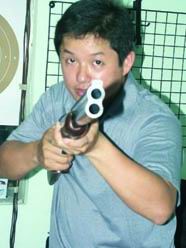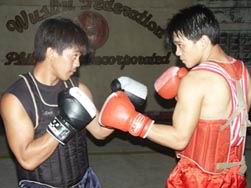| |
| |
| ----------------------------- |
|
|
|
| |
| sports |
| |
| Tamang
Tañamor |
Sapul
pa nung pagkabata ay sapul na ng mga kamao ni Harry
Tañamor ang mga nakakasuntukan niya. Itong
lakas ng kamao ng kaliweteng taga-Zamboanga City
ang naghatid sa kanya sa ibabaw ng ring.
Nagsimula siyang mag-boksing
noong 1995, habang siya ay nag-aaral sa Zamboanga
City High. Ang panglima sa siyam na anak ni Conrado
at Lilia Tañamor ay lumahok at nanalo sa
Palarong Pambansa hanggang sa kunin siyang boksingero
ng Amateur Boxing Association of the Philippines
(ABAP).
Hindi naman nabigo ang ABAP
sa pagpili sa kanya. Tama rin ang pasya ni Harry
na maging pambansang boksingero. Binigyan niya ng
karangalan ang Pilipinas at sinalba pa niya sa kahihiyan
ang ABAP nang tanging siya lamang sa mga boksingerong
Pilipino ang nagwagi ng medalya sa katatapos na
Asian Games sa Busan, South Korea. |
|
 |
| Harry
Tañamor |
| |
| |
|
|
May
taas na limang talampakan at limang pulgada, isa-isang
tinalo ni Harry ang kalabang taga-Myanmar, Tsina, Indiya
at Thailand upang marating ang pangkampeyonatong laban
sa light flyweight (48 kilo) na dibisyon. Ngunit di niya
nakamit ang gintong medlayang nang talunin siya ng kalabang
Koreano sa desisyon.
Napaulat na sariling kamao ang
naging sanhi ng pagkatalo niya. Sa unang laban pa lang
ay nasaktan na ni Harry ang kanyang kanang kamay at ininda
niya ang pamamaga nito hanggang sa huling laban niya para
sa gintong medalya. Dahil sa namamagang kanang kamay,
hindi niya nakayanang patumbahin ang Koreano.
Ngunit hindi tanggap ni Tañamor
na tinalo siya. Ayon sa kanya, simula pa lang ng laban
ay halos bumigay na ang Koreano kaya kampante ang panig
ng Pilipinas sapagkat alam nilang lamang sila sa punto.
“Talo talaga sa akin iyung
Koreano kaso sumakit iyung kamay ko pagtama sa ulo niya,”
sabi ni Harry. “Nadaya lamang tayo. Gusto ko talaga
siyang pabagsakin para malinis ang pagkapanalo natin.
Kaso magulang na, humahawak pa. Hometown decision ang
nangyari,” sabi ni Harry.
Hindi daw talaga uubra ang Koreano.
Kung tutuusin, mas nahirapan pa siya sa kalabang Tsino
at Indyan kaysa sa Koryano. Ang pinaka-malakas daw na
nakaharap niya ay ang Thai.
Sa ngayon, magaling na ang kanang
kamao ni Harry. Tanggap na rin niya ang kinahinatnan ng
labang iyon. Ngunit sa isip at damdamin ni Harry at ng
buong sambayanan, siya pa rin ang kampeon.
Pinagtutuunan ng pansin ni Harry
ngayon ang paghahanda sa Southeast Asian Games. Araw-araw
siyang nag-eensayo. Jogging at ehersisyo sa umaga at hapon.
Nagsya-shadow boxing siya, skipping rope at sparring.
Nais niyang mapanalunan ang gintong medalya para sa bansa.
Sa allowance na P8,000 kada buwan, sinisiguro ni Harry
na masusuklian niya ang suporta at tiwala ng gobyerno
sa kanya.
Ninais na niyang sumabak na sa
professional boxing noon subalit nagbago ang isip niya.
“Nag-e-enjoy pa ako sa amateur at baka kailanganin
pa ako ng bansa eh,” sagot ni Harry.
Bukod sa pagbo-boksing, ang 24-anyos
na si Harry ay kasapi ng Hukbong Sandatahan ng Pilipinas
mula pa noong taon 2000. Siya ay may ranggong Private
First Class.
Ang nangyari kay Tañamor
sa kamay ng Koryano sa Busan Asian Games ay tulad ng pagdaya
ng Koryano din kay Onyok Velasco sa Olympic Games noong
1998. Subalit hindi dito nagtatapos ang karera ni Harry
sa larangan ng boksing. Alam niyang maka-kaharap niyang
muli ang Koryano at sa pagkakataong ito, titiyakin ni
Harry na hahalik muna siya sa kanyang matitigas na kamao
bago sa ring. Ipatitikim niya sa kalaban ang tamang Tañamor.
|
| |
| Shotgun
marriage |
World-renowned
sharpshooter Jethro T. Dionisio has gotten tired
of stationary shooting and has divorced his pistol.
He is now into trap shooting and is engaged to a
shotgun.
“Medyo nababagalan
na kase ako sa precision shooting eh kaya nag-iba
naman ako,” the 30-year-old Jethro said.
The affair has bore fruit:
a bronze medal in the Busan Asian Games.
Jethro scored 117 out of
125 shots, a total of eight missed to salvage third
place, in the trap shooting event.
In trap shooting, the shooter
shoots claybirds thrown to the air. Each thrown
claybird, which has a diameter and thickness of
four inches, moves at 75 miles per hour.
Jethro considers the feat
as his best performance so far in the single shotgun
event.
He admitted feeling nervous
at first. But he was able to deliver despite the
tension.
|
|
 |
| Jethro
Dionisio |
| |
| |
|
|
Together
with Jimmy Recio and Eric Ang, he also won a bronze medal
in the team trap shooting.
Thanks to his 30-inch barrel,
12-gauge, two-round cap Perazzi. The Italian-made shotgun
can find its target at a range of 50 yards. The right
gun for the right man. Perfect combination.
After the smoke of the Busan gun
battle cleared, Jethro immediately went back to the country
and brought his prize to his wife Kathryn, 29, who just
gave birth to their second child at St. Luke’s Hospital.
They named the newborn Kelsy Zette. Their eldest daughter
is two-year-old Kierstenn Zette.
Jethro is now conditioning his
mind and body for the coming Southeast Asian Games. “As
early as now, I’m preparing na for the coming event.
I do physical fitness, I jog, I play badminton to condition,”
he said. |
| |
| ‘Ghost’
boxers, real heroes |
 |
|
Wu
Shu is an unpopular sport to Filipinos so the two
silver medals earned by two Ilocanos in this event
in the Busan Asian Games went unnoticed. In fact,
not even the names of Wu Shu Sanshou (full contact
kickboxing) fighters Marvin Sicomen, 21, and Rexel
Nganhayna, 23, will ring a bell to ordinary Pinoy,
except to their coaches and teammates.
Despite their ghostly image,
Sicomen and Nganhayna are real heroes. In Busan,
Marvin of La Trini-dad, Benguet defeated Wu Shu
Sanshou fighters from Kyrgystan, Yemen and Laos
before bowing to a Chinese in the finals of the
|
| Marvin
Sicomen (left) and Rexel Nganhayna. |
| |
| |
|
|
52-kilo division.
Rexel of Baguio City eliminated Indonesian, Vietnamese
and Mongolian opponents before losing the gold to a Thai
in the 56-kg category.
They came. They fought. They struggle.
They won...and lost. They did their best. Their determination
earned them the glorious silver medals, a feat that is
quite impossible to achieve in a very competitive sports
contest like the Asian Games. They brought honor to the
Philippines.
Despite the lack of recognition,
Marvin and Rexel got consolation in the form of cash incentives
worth close to a million pesos. The incentive is really
be a big help for them and their families. Rexel’s
parents were able to start a piggery business because
of the money he earned from winning Wu Shu competitions.
Marvin, who is the 4th of nine
siblings, plans to use his cash prize to help his parents,
whose only source of income is planting Chrysanthemum.
Marvin and Rexel resumed practice
this time aiming to capture gold medals in next year’s
Southeast Asian. They are back in trai-ning from where
they started their career, at the condemned Eva building
at 239 Juan Luna St., Binondo, Manila.
It was in this building that Wu
Shu Sanshou national coach Yu Zhi Po, taught them this
martial arts, which originated in China centuries ago.
|
| |
|
| |
| Outside
the hardcourt |
I
had the great and exciting experience of covering
the recently concluded Busan Asian Games in South
Korea. I’m sure Pinoys working in that part
of Asia know how scenic the place is. I saw a lot
of interesting places. But one of the things that
caught my eye was the Athletes’ Village, home
to our athletes in the 14th Asiad.
Constructed on an 115,100
square-meter lot in a convenient location, the Athelete’s
Village housed over 13,000 athletes and officials
all over Asia. It had 20 apartment-style buildings
with 2,290 units.
I went around the site and
saw that the place, though huge, was not yet finished.
The foundations were constructed, but there was
hardly any furnishing inside. Flooring was still
raw, as well as the walls and ceilings. Nonetheless,
the facilities were there.
There are many facilities
to meet athletes’ needs. Scattered within
the village are a bank, a photo shop, a laundry
shop and even a tailor shop in a vacant elementary
school nearby.
For leisure, athletes can
go to the coffee shop, discotheque, Internet plaza,
and lounge. There is a small shopping area selling
different native products of Korea. Korean fans,
Korean dolls and masks were what I found interesting. |
|
 |
|
| The
author at the Athletes Village |
|
| |
| |
|
|
|
There’s
also a Nike booth that sold apparel, shoes and accessories
such as bags; and a convenience store where one can buy
snacks and toiletries.
An interesting area of the school
was the Game Room. Here, athletes played video games.
I saw a Dance Rev machine! It’s like Timezone, with
Korean flair. I noticed that aside from Koreans and Japanese,
players from Qatar and the Mid East countries enjoyed
playing video games.
There’s a Video Viewing
Room, an Art Studio and even a Karaoke Room too!
For those who wonder where Asi
Taulava and Andy Seigle got their haircut, it’s
at the Barber/Beauty Salon Room.
Aside from training everyday and
visiting the barber, what else did our ballers do in the
village? Jeff Cariaso and some of the players lifted weights
in the Sports Center daily for 1-2 hours.
Food was served at the cafeteria
all day where security was very strict.
Andy Seigle said he was starting
to look like a Korean because of all the Korean food served
every time he eats there. Luckily for them, they brought
canned goods from Purefoods when they left Manila. So,
whenever they got sick of Korean food, there were the
old reliables - pork and beans, sausage, corned beef and
chili con carne anytime, any day. And for Pinoy fiesta
flavor, there’s even paksiw na lechon. Yummy!
This is definitely one of the
experiences I would treasure, long after the memory of
the Asian Games fades. The players tasked with bringing
home the bacon from the quadrennial meet are back in Manila.
Some have sad stories. Others, like the basketball team,
have bittersweet tales; while a few came back with glory
and pride with their medals.
Busan, for its part, is back to
normal operations. What was once the Athletes’ Village
is now an area with pre-sold housing units for middle-class
Koreans. That’s smart planning for you — dual
purpose for the structures built for the Asiad. I wonder
if the Philippines could pull-off something like that. |
| |
|
|
|
|
|
|
|
|
|
|
|
|
|
|



